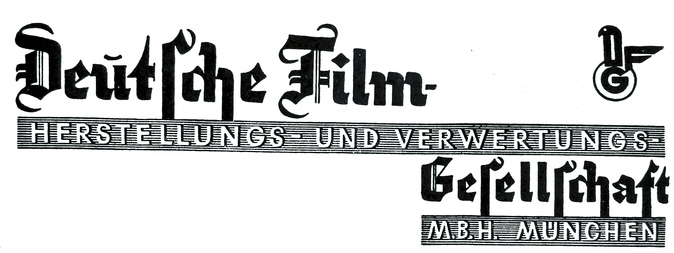
The DFG, or roughly, The German Film Production and Administrative Company Ltd. is known today for having been the production company of record for the notorious anti–semitic hate film, Der ewige Jude. Very little about the company otherwise is published in film histories. The company was established by the NSDAP's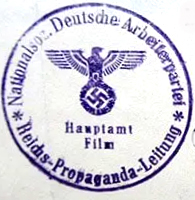 Reichsparteipropagandaleitung, or Nazi Party Propaganda wing, and between 1937 and 1945 produced forty–four films, all but one of which were classified as Kurzfilme, or "shorts;" other than 1942's Hände Hoch!, which was a full-length Hitler Youth feature film. The DFG's Feldzug in Polen and Deutsches Land in Afrika were also feature-length documentaries, and The March to the Führer was about 47 minutes in length. The film, Die große Zeit, ran 70 minutes. See below for summaries of each of these films.
Reichsparteipropagandaleitung, or Nazi Party Propaganda wing, and between 1937 and 1945 produced forty–four films, all but one of which were classified as Kurzfilme, or "shorts;" other than 1942's Hände Hoch!, which was a full-length Hitler Youth feature film. The DFG's Feldzug in Polen and Deutsches Land in Afrika were also feature-length documentaries, and The March to the Führer was about 47 minutes in length. The film, Die große Zeit, ran 70 minutes. See below for summaries of each of these films.
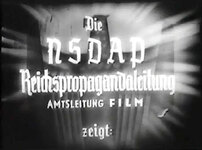 The DFG was a company integrated into the NSDAP's Film Division (Filmabteilung) overseen by long-time early Party member and fanatical anti–Semite Arnold Raether (shown at left below.) There is a letter in the German Federal Archives (Akte NS22/905) in which he, a year before Hitler's rise to power, has written Dr. Robert Ley, then at the Party's Munich "Brown House," to point out the number of Jews working at Germany's largest film studio, Ufa, in Berlin. Also in this file are minutes of a Nazi Party Executive Committee with Hess and Bormann and other top leaders discussing whether the Party will take over the existing studios or simply
The DFG was a company integrated into the NSDAP's Film Division (Filmabteilung) overseen by long-time early Party member and fanatical anti–Semite Arnold Raether (shown at left below.) There is a letter in the German Federal Archives (Akte NS22/905) in which he, a year before Hitler's rise to power, has written Dr. Robert Ley, then at the Party's Munich "Brown House," to point out the number of Jews working at Germany's largest film studio, Ufa, in Berlin. Also in this file are minutes of a Nazi Party Executive Committee with Hess and Bormann and other top leaders discussing whether the Party will take over the existing studios or simply 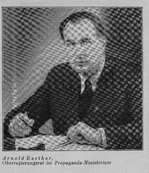 work with them to produce pro-NS films. To find time to discuss such matters, the Party seems quite certain that it will be taking power at some point soon. Another letter by Raether to Gregor Strasser in the Party's Munich offices discusses the notification that henceforth the Filmabteilung under Raether will report to Dr. Goebbels -- again, a year before the assumption of power. Raether later produced the ill–fated Sieg des Glaubens Reichs Party Day film, which Leni Riefenstahl adamantly denied existed – never mind that she actually directed it, until a print was found and released by AM Productions in California on DVD.
work with them to produce pro-NS films. To find time to discuss such matters, the Party seems quite certain that it will be taking power at some point soon. Another letter by Raether to Gregor Strasser in the Party's Munich offices discusses the notification that henceforth the Filmabteilung under Raether will report to Dr. Goebbels -- again, a year before the assumption of power. Raether later produced the ill–fated Sieg des Glaubens Reichs Party Day film, which Leni Riefenstahl adamantly denied existed – never mind that she actually directed it, until a print was found and released by AM Productions in California on DVD.
The official outline of the role of the DFG was spelled out in an internal memorandum dated October 10, 1938 by the Reich Propaganda Directorate (RPL) found in records of the Reichsfilmkammer in our possession:
Transcript/ Bh.Memorandum from the Reich Propaganda Directorate on the NSDAP's film work to be aligned with general German filmmaking.
The Party's propaganda activities in cinema locations are further supported by the industry as part of its supporting programs. The films required for these purposes are produced by the German Film Production and Ververtungs-Gesellschaft GmbH (DPG) unless State or economic policy propaganda films have been produced as part of the industry's supplementary program production. The Reichapropaganda management decides which industrial films are to be recognized as propaganda films.
The DFG's manufacturing monopoly for the party, its branches and affiliated associations:
Party divisions:
S.A. S.S. H.J. B.D.M. N.S.St.B. N.S.K.K. N.S.F.K. N.S. Womanhood Main Office for Public Health,
and affiliated associations:
Nazi Teachers' Association Nazi Law Keepers Association NS Medical Association N.S.K.O..V. Reich Association of German Officials IS-Bund German Technology D.A.F.
is a concern of the party itself, over which the Reich Commissioner for the German Film Industry has no influence. Should such an organization wish to have a film made by one of the companies I manage, Mr. Raether would decide whether the production of this film would be more appropriately carried out by the DFG or one of the companies I look after. For the current production year, however, the program has already been determined, with the exception of the accompanying programs for the Wien Film production, which is only just starting up. The production of non-political cultural and heritage filming is generally a matter for the industry.
As far as the Reich Propaganda Leadership (RPL) or in their commission from DEUTSCHE Filmproduktions- und Verfassungs-gesellschaft m.b.H. if it produces state-political or political propaganda and illustrative films, it must be released from all licenses on the part of Tobis-Tonbild-Syndikat AG that arise from the production, reproduction the distribution and presentation of such films in the German Reich. In general, these films are limited to 600 m in length, but films that are produced longer for propaganda reasons must also be included in the license exemption. The Party's film work is based exclusively on the requirements of its objectives. Exceptional propaganda requirements therefore require a possible change to the above measures, whereby the Party and State necessities are decisive for the implementing provisions.
Transcript/ Bh. Memorandum from the Reich Propaganda Directorate on the NSDAP's film work to be aligned with general German filmmaking. — 4. I0.1938. [the first person “I” in the text above being Dr. Joseph Goebbels.] This 6-page document has no file number, but was sent over a memo on 2 October 1941 by the RFK's Fachgruppe Filmaußenhandel to remind all members of its Central Committee, which was dedicated to the commercial export of German films duirng WWII. This 1941 memo #FFA-Schw/Sa 953.
The NSDAP’s first use of film as a propaganda medium took place back in 1927, when silent film, some 670 m. long, was shot of the August 20/21 „Parteitag der NSDAP,“ which was premiered on 9 December of that year.
Ten years later, in the summer of 1937, the Propaganda Ministry’s Film Department – the Abteilung Film– established a new film production company, the DFG, and headquartered it conveniently on the same street as the Abteilung Film, itself. The first chief of the DFG was Dr. Walter Scheuenmann, whose title was Produktionsleiter, or Head of Production.
The DFG’s output, through to it’s last film of 10 January 1945, was:
1937 (Dr.Walter Scheuenmann, Head of Productuions, DFG)
9.10 Ostlandfahrt der SA-Standarte 9. (575m.)
13.11 Was ist los? (169m, political advertising film)
4.12 Festliches Nürnberg (599m. Parteitagfilm)
1938 (The Propaganda Ministry’s Hans Weidenmann becomes the head of DFG)
12.3 Volk baut in die Zukunft (292m. HJ film)
4.4. Die große Zeit (1923m. Anschlußfilm)
14.5 Heime der Hitler–Jugend. (357m.)
2. 7. Führertag in Italien (732m.)
1939 (On 25 August, Fritz Hippler made Head of the Abteilung Film in the Propaganda Ministry, and henceforth oversaw the DFG productions along with all other NSDAP-produced films. Until his dismissal in 1943.)
23.1. Als es 1900 wurde. (1388m.)
Glanz und Elend der Flimmerkiste (343m)
29.3 Deutsches Land in Afrika (1855m)
1.4 Schicksalswende (957m)
21.8 Unsere Jungen (540m; NAPOLA film)
5.10 Eine Division greift an (379m)
3.11 Einstaz der Jugend (595m)
28.11 Dein Wald (375m)
1940
25.1 Der Marsch zum Führer (1324m)
30.1 Die Erde ruft (527m)
2.2 Glaube und Schönheit (453m)
28.4 Die große Reserve (390m)
22.4 Unsere Kinder – unsere Zukunft (384m)
11.5 Die Wehrmannschaft (518m)
4.11 Der ewige Jude (1820m)
1941
15.3 Steinmetz am Werk (518m)
29.3 Motor-HJ im Sattel (191m, silent)
30.6 Das Seidendorf (430m)
Soldaten vom morgen (400m.)
1942
10.1 Außer Gefahr (600m; Kinderlandverschickung)
11.4 Feind fliegt ein (405m)
22.6 Hände Hoch! (1830m, HJ-Spielfilm)
Pioniere voran! (497m)
17.8 Junges Europa -I (403m)
26.10 Junges Europa –II (409m)
21.12 Junges Europa –III (411m)
1943
16.1 Flugzeug in Seenot (431m)
9.3 Junges Europa –IV (370m)
1.7 Junges Europa – V (363m)
20.11 Junges Europa –VI (388m)
1944
14.4 Junges Europa –VII (407m)
1945
10.1 Junges Europa –VIII (419m)
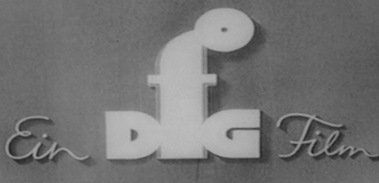
This completes the DFG-branded films released before the war's end. Many other film shorts were released during this period by the RPL, of which DFG was an integral part, but those films, such as the 1937 euthanasia film Opfer der Vergangenheit, were not "DFG" releases like the 44 film titles listed above. The RPL films were credited to the RPL/NSDAP.
The following films are represented by rare posters in our Poster Collection, and can be found in our Poster Gallery on this website, by clicking on the blue film title.
The great Time (Die große Zeit, 1938) ... Production Company
A 70 minute film documenting showing the "new construction of the Reich" ––such as the Anschluss with Austria, the Olympic stadium and 1936 Games, the Autobahns, the return of the Saarland to Germany, the re–armament of German armed forces, and the pageantry of the Nürnberg Party Raliies. Produced by Carl Junghanns.
The Eternal Jew (Der ewige Jude, 1940) ... Production Company
Hippler's quasi-documentary needs no introduction.
The March to the Führer was discussed by Arnold Raether as early as 1936 and was meant to be a film directed by Hitler Youth themselves. After some early film clips were screened at a HJ gathering in 1937, the production was turned over to DFG to be produced more professionally for cinema release. It was finally released in May 1940 a good year after such marches were suspended for the duration of the war, and so never took place again. By the time the film was released, its HJ participants were actively serving in WWII.
Campaign in Poland (Feldzug in Polen, 1940) ... Production Company
One of DFG's most widely-seen and highly praised documentaries shown across Europe in its day.
Deutsches Land in Afrika (German Lands in Africa, 1939) ... Production Company
This film, made as WWII was about to erupt, told the story of Germany's pre-WWI colonies, and offered footage of Hitler Youth and German Maidens in German settlements in Africa ready to support Greater Germany's demand for the return of its former colonies.
Hände Hoch! (Hands Up!, 1942) – DFG Production Company
Hände Hoch! is the story of HJ boys being evacuated from their German city to the safely of the Tatra Mountains in Slovakia, an ally of Nazi Germany, and their adventures there in which they capture smugglers wanted by the local police. Hände Hoch! is a 67 minute feature film directed by Alfred Weidenmann, a propaganda officer who worked in the the HJ Central Leadership Office. He was a prolific author of boy's adventure books, including a long series of HJ novels. His non-political books were still in print after 1945, and a few can still be found in print today. He made his finest HJ feature film, Junge Adler, for Uƒa in 1944. He had a very successful film career as a Director in the BRD, and also major TV series hits such as Derrick until his death in 2000 in Switzerland. In all, he made 36 films between 1942 and 1984.
Junges Europa
Although no posters or other publicity materials are to found either in our Collection nor anywhere else to our knowledge, it would be remiss for us not to mention these DFG short films, as well:
Junges Europa - Filmschau der Hitlerjugend (1942–1945 – DFG Production Company)
To bolster morale amongst the German youth in the latter war years, Alfred Weidenmann produced a series of eight shorts entitled Young Europe, which ran between 11 and 14 minutes long, with fast-paced editing, quick story-telling, newsreel type reportage, set to music, including the opening title sequence for each film using Baldur von Schirach's "Unsern Fahne flattert uns voran" song made famous in Hitlerjunge Quex. The films not only covered HJ events but also highlighted all the many various fascist youth groups across Europe, from Falangist Spain to the Baltic States, providing a panaroma of European youth dedicated to the ideal of a New Order in contrast to the Plutocratic England and Bolschevik terror of the asiatic East. The first episode of Young Europe was released in 1942 and the last one in early 1945.
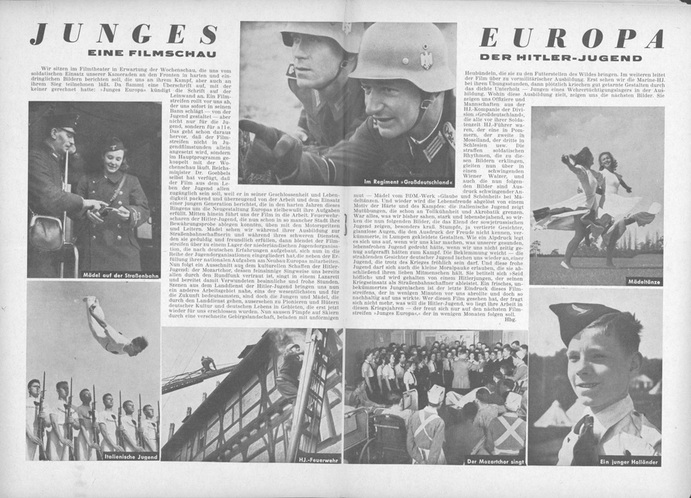
The DFG was located at Belle-Alliance-Strasse 45 in Berlin, across from the NSDAP''s Reichsparteileitung on the same street at #38. The building housing the DFG was bombed out in late WWII and the building demolished after the war. A modern structure now occupies part of the old site, along with a city thoroughfare. This is undoubtedly one reason why materials on the DFG, its history and fllm work are so scarce, and also why original posters and even stills for its films listed above are so rare. Surviving copies probably were those outside of Berlin at war's end -- displayed in cinemas or Filmabteilung branch offices, and thereby escaping destruction in Berlin either through terror bombing, the rampaging Red Army and the post-war looting and burning of NS materials.
Another reason why some files - almost whole years - are missing from the German archives is that 18 volumes representing years 1929–1945 of original RPL documents are in the so-called "Special archive" (Sonderarchiv) of the Central Military Archives of Moscow. This fact is on the German Federal Archives website: ( i.e.: 18 Bände der RPL aus dem Zeitraum 1929-1945 befinden sich im sog. "Sonderarchiv" in Moskau, inzwischen Bestandteil des Russischen Zentralen Militärachivs.)

 Reichsparteipropagandaleitung, or Nazi Party Propaganda wing, and between 1937 and 1945 produced forty–four films, all but one of which were classified as Kurzfilme, or "shorts;" other than 1942's Hände Hoch!, which was a full-length Hitler Youth feature film. The DFG's Feldzug in Polen and Deutsches Land in Afrika were also feature-length documentaries, and The March to the Führer was about 47 minutes in length. The film, Die große Zeit, ran 70 minutes. See below for summaries of each of these films.
Reichsparteipropagandaleitung, or Nazi Party Propaganda wing, and between 1937 and 1945 produced forty–four films, all but one of which were classified as Kurzfilme, or "shorts;" other than 1942's Hände Hoch!, which was a full-length Hitler Youth feature film. The DFG's Feldzug in Polen and Deutsches Land in Afrika were also feature-length documentaries, and The March to the Führer was about 47 minutes in length. The film, Die große Zeit, ran 70 minutes. See below for summaries of each of these films. The DFG was a company integrated into the NSDAP's Film Division (Filmabteilung) overseen by long-time early Party member and fanatical anti–Semite Arnold Raether (shown at left below.) There is a letter in the German Federal Archives (Akte NS22/905) in which he, a year before Hitler's rise to power, has written Dr. Robert Ley, then at the Party's Munich "Brown House," to point out the number of Jews working at Germany's largest film studio, Ufa, in Berlin. Also in this file are minutes of a Nazi Party Executive Committee with Hess and Bormann and other top leaders discussing whether the Party will take over the existing studios or simply
The DFG was a company integrated into the NSDAP's Film Division (Filmabteilung) overseen by long-time early Party member and fanatical anti–Semite Arnold Raether (shown at left below.) There is a letter in the German Federal Archives (Akte NS22/905) in which he, a year before Hitler's rise to power, has written Dr. Robert Ley, then at the Party's Munich "Brown House," to point out the number of Jews working at Germany's largest film studio, Ufa, in Berlin. Also in this file are minutes of a Nazi Party Executive Committee with Hess and Bormann and other top leaders discussing whether the Party will take over the existing studios or simply  work with them to produce pro-NS films. To find time to discuss such matters, the Party seems quite certain that it will be taking power at some point soon. Another letter by Raether to Gregor Strasser in the Party's Munich offices discusses the notification that henceforth the Filmabteilung under Raether will report to Dr. Goebbels -- again, a year before the assumption of power. Raether later produced the ill–fated Sieg des Glaubens Reichs Party Day film, which Leni Riefenstahl adamantly denied existed – never mind that she actually directed it, until a print was found and released by AM Productions in California on DVD.
work with them to produce pro-NS films. To find time to discuss such matters, the Party seems quite certain that it will be taking power at some point soon. Another letter by Raether to Gregor Strasser in the Party's Munich offices discusses the notification that henceforth the Filmabteilung under Raether will report to Dr. Goebbels -- again, a year before the assumption of power. Raether later produced the ill–fated Sieg des Glaubens Reichs Party Day film, which Leni Riefenstahl adamantly denied existed – never mind that she actually directed it, until a print was found and released by AM Productions in California on DVD. 



